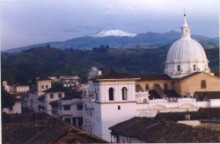Architecture Schools and Programs in Colombia
Find Schools by City:
BogotaCaliSan Juan de PastoArchitecture Studies in Colombia
 City of Popayán, ColombiaStudying abroad in a foreign country can offer you the adventure of a lifetime, especially if you choose a destination that’s a little unconventional and unique, such as the scenically stunning country of Colombia. Officially known as the Republic of Colombia, this beautiful bicoastal country is located in the northwestern corner of South America, bordering the Caribbean Sea to the north and the Pacific Ocean to the west, and sharing land borders with Panama to the northwest, Venezuela and Brazil to the east, and Ecuador and Peru to the south. Colombia is the 26th largest country in the world by total area, and the fourth-largest country in South America after Brazil, Argentina and Peru. With nearly 47 million inhabitants, it is the 27th largest country in the world by population and has the second-largest population of any Spanish speaking country, after Mexico.
City of Popayán, ColombiaStudying abroad in a foreign country can offer you the adventure of a lifetime, especially if you choose a destination that’s a little unconventional and unique, such as the scenically stunning country of Colombia. Officially known as the Republic of Colombia, this beautiful bicoastal country is located in the northwestern corner of South America, bordering the Caribbean Sea to the north and the Pacific Ocean to the west, and sharing land borders with Panama to the northwest, Venezuela and Brazil to the east, and Ecuador and Peru to the south. Colombia is the 26th largest country in the world by total area, and the fourth-largest country in South America after Brazil, Argentina and Peru. With nearly 47 million inhabitants, it is the 27th largest country in the world by population and has the second-largest population of any Spanish speaking country, after Mexico.Architecture Education in Colombia
Post-secondary education is highly valued in Colombia and its universities, many of which offer a comprehensive education in architecture, are among the best on the continent. One such institution is the Universidad de los Andes (University of the Andes), located in Bogota, the capital and largest city in Colombia.At the University of the Andes, the undergraduate architecture curriculum is structured in three cycles:
- Basic Cycle. The basic cycle consists of the first and second semesters, or typically he first full year (out of five). At this stage, students are offered a comprehensive experience in architecture and built environments, with techniques that include observation, measurement, analysis and representation of significant buildings. Teaching methods involve both theoretical and practical activities, and the courses offered in this cycle are mandatory.
- Training Cycle. In the training cycle, which consists of the third, fourth and fifth semesters, students are offered a thorough understanding of architecture as a discipline. The courses are organized into four key areas: project history, theory and criticism, art and city. The teaching methods aim to ensure the transmission of specific knowledge in each area, and again, these courses are mandatory.
- Purposeful Cycle. Consisting of the sixth through the tenth semesters, the Purposeful Cycle aims to stimulate students’ critical and proactive attitude, which will ultimately enable them to propose comprehensive solutions and alternatives relating to architecture and built environments (cities). In this stage, students are afforded the opportunity to delve specifically into a particular area of interest, with teaching methodologies that encourage research and debate. These courses are electives.
The School of Architecture is divided into four subject areas—areas in which students can place their focus during the third cycle. They are: architectural project design; architectural history, theory and criticism; city/urban planning; and architectural technique.
Why Study Abroad in Colombia
Once infamous for its drug cartels and decades of civil conflict, Colombia is now a country on the rise and one of the best-kept secrets in South America. Never in the nation’s history has there been a better time for international students to experience Colombia firsthand, its universities, architecture, culture and scenic beauty, ranging from tropical beaches, to rainforests, to glaciers, mountains and deserts.In Colombia’s major university cities, students will find plenty of diversions to keep them busy when they’re not hitting the books in the classroom. History buffs, for example, will marvel at Colombia’s charming colonial cities, consisting of 17th and 18th century buildings and monuments. Students looking to relax and blow off some steam will find just what they need under the bright lights of Bogota, the nation’s capital. There they’ll find an abundance of shops, museums, art galleries, cafes and restaurants, serving mouthwatering local and traditional fare.
There can be no debate that the people of Colombia love a good party, especially on the weekends. Come Friday and Saturday night the bars and nightclubs are jam-packed with revelers, and the music, dancing and partying continues until dawn. Also of note is the world-famous Barranquilla Carnival - second only to that of Rio de Janeiro in the South American carnival calendar. This celebration has been designated by the United Nation’s UNESCO body as one of the “Masterpieces of the Oral and Intangible Heritage of Humanity.” Or in other words: “It is a rocking good time.”
Colombia’s diverse culture features a unique mixture of Spanish and indigenous African influences, and its people are proud and hard-working. Its culture of hospitality, especially towards foreign visitors, means that the people you encounter in Colombia will not only be some of the kindest people you have ever met, but also one of the highlights of your time spent studying abroad in this very amiable nation.

